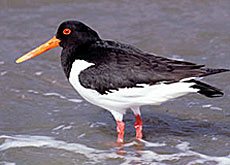Birds “divorce” to boost social status

Swiss ornithologists studying the mating habits of oystercatchers have found that - as with humans - marriages don't last.
They say that eight per cent of oystercatchers – mainly females – dump a mate in order to move up in the world.
“Females try to improve their social status,” ornithologist Dik Heg told swissinfo.
Researchers found that females living in poor nesting spots were particularly likely to initiate a split and snap up a more upwardly mobile partner.
The findings were released by a team of scientists from Bern University who have been studying oystercatchers on the Dutch island of Schiermonnikoog for the past eight years.
“What we found was that one of the pair initiates the divorce and decides to move from the territory to pair up with a new individual,” said Heg.
He explained that individuals – usually female – left mates in order to boost their prospects and their reproduction rate.
Divorce rate
According to the research team, birds that initiate a split usually land a superior nesting spot and bear up to 20 per cent more chicks.
The dumped partner often sees their prospects decrease substantially, ending up in a poor nesting spot, a long way from feeding grounds.
Andre Dhondt, an expert in bird behaviour at Cornell University in New York, told “Nature” magazine that the study backed up the idea that birds divorce to increase their reproductive success.
Previously it had been difficult to prove in other bird populations which partner flew the nest first.
But Heg maintains that, with a divorce rate of eight per cent, oystercatchers are relatively faithful.
The greater flamingo on the other hand has a divorce rate of almost 100 per cent, while the albatross has never been observed to ditch a mate.
The albatross, says Heg, is “the pinnacle of monogamy in the bird kingdom”.
swissinfo, Daniela Silberstein
Swiss ornithologists have been studying the behaviour of oystercatchers off the Netherlands’ coast for the past eight years.
They found that eight per cent of birds – mainly females – “divorce and seek better nesting sites and partners.
The divorce rate among adult Swiss is around 40%.

In compliance with the JTI standards
More: SWI swissinfo.ch certified by the Journalism Trust Initiative

You can find an overview of ongoing debates with our journalists here. Please join us!
If you want to start a conversation about a topic raised in this article or want to report factual errors, email us at english@swissinfo.ch.